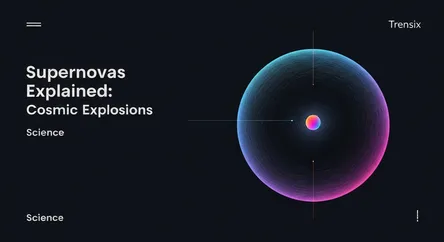Science
Supernovas Explained: Cosmic Explosions

Discover supernovas, the universe's most powerful stellar explosions. Learn how dying stars create new elements and shape the cosmos.
What is it?
A supernova is the explosive death of a star, marking one of the most energetic events in the universe. It occurs in two main ways: either a massive star collapses under its own gravity after exhausting its nuclear fuel, or a white dwarf star in a binary system accumulates too much matter from its companion. In either case, the result is a cataclysmic explosion that can briefly outshine an entire galaxy. This blast releases tremendous amounts of energy and expels the star's material into space, leaving behind a dense remnant like a neutron star or a black hole.
Why is it trending?
Supernovas are a constant focus for astronomers using next-generation instruments like the James Webb Space Telescope. These powerful observatories allow for detailed study of supernova remnants, providing new insights into the life cycles of stars and the chemical evolution of galaxies. Furthermore, specific types of supernovas are used as 'standard candles' to measure cosmic distances, which is crucial for understanding dark energy and the accelerating expansion of the universe. The hunt for the next supernova in our own galaxy keeps the topic exciting and relevant.
How does it affect people?
Supernovas are fundamental to our existence. The elements heavier than hydrogen and helium, including the oxygen we breathe and the iron in our blood, were forged in the hearts of stars and scattered across space by supernova explosions. Without these ancient cosmic blasts, the raw materials for planets, and life itself, would not exist. We are literally made of stardust created and distributed by supernovas billions of years ago. They are a direct link to our cosmic origins and the ongoing cycle of creation in the universe.